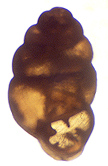Classification of Tapered Vertigo
Classification of Tapered Vertigo (Burch 1962)
 Domain - Eukarya
Domain - Eukarya
Kingdom - Animalia
Phylum - Mollusca
Class - Gastropoda
Subclass - Pulmonata
Order - Stylommatophora
Family - Pupillidae
Subfamily - Vertigininae
Genus - Vertigo
Species - elatior
Full name
- Vertigo elatior Sterki, 1894
Why is the tapered vertigo classified as
it is?
The tapered vertigo is eukaryotic because it is
multicellular and has membrane bound organelles. It
lands in the Kingdom Animalia by having a digestive
system, reproductive structures, and being
heterotrophic (Parker
2011). Next, it is classified in the Phylum
Mollusca because of the characteristics of
lophotrochozoa, having bilateral symmetry, has more
than two cell layers, a body type with three main
parts (head/foot, mantle, and visceral mass), a
complete digestive system, having a true coelom,
body can vary in form (mollusk = soft body), may
possess shells, has nervous system, open circulatory
system (most), protostome development, and has gaseous
exchange organs (Hickman
2009). Furthermore, the tapered
vertigo is under the Class Gastropoda. Most
gastropods have a coiled shell that the body can be
withdrawn into others have lost the shell, for
example, the slugs (Myers
and Burch 2001). Gastropods can also be
characterized by torsion, which allows them to twist
or rotate the visceral mass and mantle so that the
mantle cavity becomes anterior (Myers
and Burch 2001). This process occurs in the
larval (veliger) stage which leads to the head and
mouth being under the anus and twisting of the gut
and nervous system (Myers
and Burch 2001). More specifically the tapered vertigo is classified
in the subclass Pulmonata and order Stylommatophora
which indicates that it is terrestrial (Burch
and Myers 2008). The adaptations to
living in a terrestrial habitat include lungs, which
are developed from the mantle (Burch
and Myers 2008). Other features of the
Pulmonata subclass are having two pairs of tentacles
and a highly concentrated nervous system (Burch
and Myers 2008). Common features of the
shell from the Family Pupillidae include apex,
suture, penultimate whorl, body whorl, palatal
depression, crest, sinulus, and callus (Nekola
and Coles 2010).
Figure 2. Diagram of Vertigo elatior showing features
that are characteristic of the family Pupillidae (Nekola
and Coles 2010).
Finally, the genus Vertigo refers to having
a blunt summit, a shade of brown, and glossy
shells (Pilsbry
1948). Vertigo's also have heads without
tentacles (Pilsbry
1948).
![]()
![]()